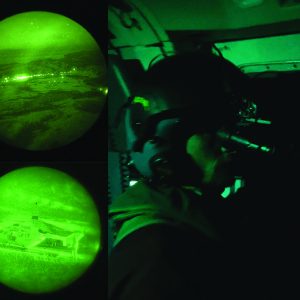At 1.30 one Friday morning the Trust Tairāwhiti Eastland Rescue Helicopter headed to Te Kaha in response to a trauma.
The call-out itself was routine – in the early hours of the morning the patient was flown in a stable condition to Tauranga Hospital.
But it might not have happened if the team was not equipped with the Night Vision Goggles (NVGs) that magnify ambient light thousands of times, allowing them to access unlit landing sites and conduct search missions under cover of darkness.
Eastland Rescue Helicopter pilot James Easterbrook has flown his fair share of NVG-equipped missions and says he doesn’t think he could do his job without them.
Mr Easterbrook flew out of the United States for some two decades then spent a couple of years off-shore flying in Alaska before moving home to New Zealand in 2018, joining the Gisborne service a year later.
As part of his employment he underwent a “pretty rigorous” training regime to use the NVGs that had been introduced to New Zealand rescue helicopters a dozen years before.
“They bring your vision down to a pretty small field so flying with them does take some getting used to,” he says.
“They can alter your depth perception, making it trickier to differentiate between what is near and what is far away, so that is what all the training is for.
“But our job would be much more difficult without them. Flying at night always has its own challenges but having NVGs makes it a whole lot safer.”
The Eastland Rescue Helicopter team has three sets of goggles, all held in secure storage.
“They don’t just hand them out to anybody . . . says crewman Jean-Pierre Jordaan, who is responsible for making sure the NVGs are maintained in tip-top condition.
“Because they can be misused the American manufacturers have regulatory processes around getting NVGs, and they need to be securely stored at all times.”
Already a seasoned crewman when he joined the Eastland Helicopter Rescue team after relocating from South Africa in early 2022, Mr Jordaan also underwent intensive training to use NVGs.
He recalls one mission where the team were in the air when they spotted the glare of light from a phone held by an injured person on a beach at Waipiro Bay.
“The patient was still five kilometres away but NVGs really emphasise any source of light so we were able to go straight to him,” Mr Jordaan says.
“That light really stands out from the visual the goggles give you when looking into the darkness. It’s like shades of light and dark, but you can actually see quite a lot.”
The NVGs focus on light sources also comes in handy when the team are conducting a search triggered by activation of a Personal Locator Beacon, adds Mr Easterbrook.
“Most PLBs come equipped with a strobe and that makes our job a whole lot easier,” he says. “That’s just one more reason why we advise people to carry their PLBs on their person rather than, for example, tucked away in a pack. Not only is it with them at all times, but it’s not under cover where we can’t see the light.”
But the NVGs are pricey. After a massive fundraising push, by 2010 the Eastland Helicopter Rescue Trust had the $150,000 needed to pay for two sets of green phosphor NVGs plus the specialist helmets, training and cockpit reconfiguration required to bring them into use.
“It was quite a fundraising target for a small trust like ours,” says EHRT chair Patrick Willock. “But a tragic accident inland from Ruatoria had reminded us that we were still short of a vital tool for helicopter rescue and we were determined to get them.”
Then in 2020, at a cost of 26,000, the Trust bought a set of the upgraded white phosphor goggles that provide a brighter visual in all kinds of conditions, while causing less eye strain for the pilots and crew.
And if future funding allows, it is keen to add another set of white goggles to the team’s arsenal to support safe flying for their many night missions.
“It is a big outlay for what looks like a small piece of equipment but they are huge in terms of our team’s operation,” Mr Willock says.
“The NVGs are absolutely essential in helping get the rescue helicopter where it is needed, when it is needed, which is exactly what it is supposed to do.”
CAPTION: Green Scene: Employing Night Vision Goggles for recent missions, members of the Trust Tairāwhiti Eastland Rescue Helicopter show how they see the world both flying over Ruatoria, and after landing at Tauwhareparae. Team pictures supplied
